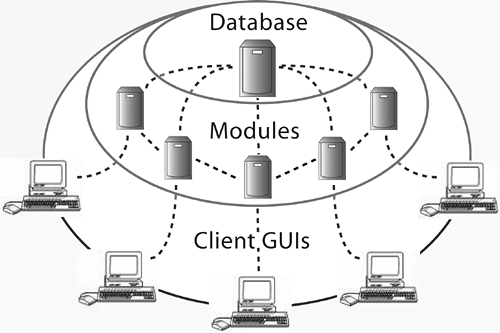What Is SAP R3?
What Is SAP R/3?SAP R/3 is a package of integrated applications called modules that record and track the activities and costs of doing business. Its roots extend back to 1972, when five system analysts, all former employees of IBM in Germany, created the software for collecting large volumes of business data in a single computer and then processing this data in real time, when the user needs it. Real-time processing was a particularly novel development at the time because the computers of the 1970s were slow, lumbering machines that required minutes, and sometimes even hours, to process large volumes of data. Since that time, SAP has grown from a small regional company to the leading provider of business enterprise software in the world. At last count, SAP R/3 is now installed at 84,000 locations in 120 countries around the world, and it is used by more than 10 million people every day. SAP is now the world's third-largest independent software vendor, and it is still growing strong. The great strength and utility of SAP R/3 are due to a large degree to its architecture or structure, which consists of functional modules, the SAP database, and the graphical user interface or GUI[2] (Figure P.1). We use the term system throughout this book to describe this three-part assemblage of software.
Figure P.1. The SAP R/3 architecture of the database, functional modules, and client graphical user interfaces (GUIs) and their respective hardware components. The modules are all connected to one another, as well as to the database server and the clients.
The functional modules are discrete software packages that are dedicated to specific tasks, such as accounting, payroll management, and inventory control (Table P.1). They are typically installed in application servers, which are computers that are capable of rapidly processing or "crunching" large volumes of data and then assembling the output of their work in a format that can be read by the user.
The database is the actual collection of business data. These data are stored inside database servers, which are computers with huge amounts of storage memory and the capacity to rapidly exchange data with the application servers. The graphical user interface or GUI appears on the desktops of the computers or clients that you use to access the software. The centerpiece of the GUI is the application window (called a session by SAP), where you enter commands and data on scenes or screens by means of your mouse and keyboard. Note: Some users may access the SAP software through Web browsers such as MS Internet Explorer. In these cases, the SAP GUI appears inside the frame of the browser window. There are many modules in the complete version of SAP R/3, but most business enterprises do not use all of them. Rather, they purchase and install or implement only those modules that they need to do their business. The selected modules are then integrated or linked to one another and to the database servers and clients by programmers, and the screens are customized or configured to fit the enterprise's needs. Once the modules are integrated, the boundaries between them vanish and they work with one another as a single, seamless software package. This aggregation of modules is also very flexible: The enterprise can often add more modules whenever they want so that the software grows as their business needs grow. |
EAN: 2147483647
Pages: 132
